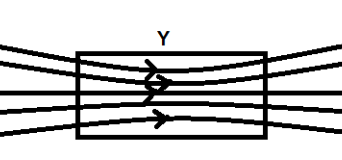
Write three properties of ferromagnetic materials.
Answer
552.3k+ views
Hint: We need to understand the different magnetic properties shown by different materials with different internal structures. We can then study the difference between the magnetic properties and thereby, answer the question for ferromagnetism.
Complete answer:
The materials on a broad scale can be classified into three different types based on their magnetic properties. The three types are – paramagnetic, diamagnetic and ferromagnetic materials.
We can discuss the properties of the ferromagnetic materials. Ferromagnetic materials are those which have strong attraction to the applied external magnetic fields. They are entitled to have inbuilt magnetic dipole moments which give them this property. The main properties of a ferromagnet are –
1.They have inbuilt magnetic dipole moments due to the specific electronic configuration in which these materials are made of. They have unpaired electrons in the sub shells which gives the magnetic dipole moment.

2.They get to align their magnetic dipole moments themselves in the direction of the external magnetic field. This property makes them attractive in the external magnetic field. They align to a common direction forming a domain which makes their attraction powerful.
3.The ferromagnets can be converted to permanent magnets easily by keeping them as an electromagnet for a short while. They have a magnetic permeability so high, i.e.,
\[\mu >1000\]
This property helps them endure the magnetic property even after the external magnetic field is removed.
4. The ferromagnets can be converted to paramagnets once the temperature of the material is raised over the Curie temperature of the material.
This is the required solution.
Note:
The ferromagnetic materials which have a wider hysteresis curve are used in making permanent magnets as they can retain their magnetic properties for a longer time. The soft iron is one of such ferromagnetic materials used in making permanent magnets.
Complete answer:
The materials on a broad scale can be classified into three different types based on their magnetic properties. The three types are – paramagnetic, diamagnetic and ferromagnetic materials.
We can discuss the properties of the ferromagnetic materials. Ferromagnetic materials are those which have strong attraction to the applied external magnetic fields. They are entitled to have inbuilt magnetic dipole moments which give them this property. The main properties of a ferromagnet are –
1.They have inbuilt magnetic dipole moments due to the specific electronic configuration in which these materials are made of. They have unpaired electrons in the sub shells which gives the magnetic dipole moment.

2.They get to align their magnetic dipole moments themselves in the direction of the external magnetic field. This property makes them attractive in the external magnetic field. They align to a common direction forming a domain which makes their attraction powerful.
3.The ferromagnets can be converted to permanent magnets easily by keeping them as an electromagnet for a short while. They have a magnetic permeability so high, i.e.,
\[\mu >1000\]
This property helps them endure the magnetic property even after the external magnetic field is removed.
4. The ferromagnets can be converted to paramagnets once the temperature of the material is raised over the Curie temperature of the material.
This is the required solution.
Note:
The ferromagnetic materials which have a wider hysteresis curve are used in making permanent magnets as they can retain their magnetic properties for a longer time. The soft iron is one of such ferromagnetic materials used in making permanent magnets.
Recently Updated Pages
Master Class 12 Business Studies: Engaging Questions & Answers for Success

Master Class 12 Economics: Engaging Questions & Answers for Success

Master Class 12 English: Engaging Questions & Answers for Success

Master Class 12 Maths: Engaging Questions & Answers for Success

Master Class 12 Social Science: Engaging Questions & Answers for Success

Master Class 12 Chemistry: Engaging Questions & Answers for Success

Trending doubts
What is meant by exothermic and endothermic reactions class 11 chemistry CBSE

Which animal has three hearts class 11 biology CBSE

10 examples of friction in our daily life

One Metric ton is equal to kg A 10000 B 1000 C 100 class 11 physics CBSE

1 Quintal is equal to a 110 kg b 10 kg c 100kg d 1000 class 11 physics CBSE

Difference Between Prokaryotic Cells and Eukaryotic Cells




